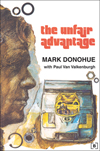|
|
The Unfair Advantage
by Mark Donohue
Price: $49.95
|
MARK DONOHUE: A BOY'S ENTHUSIASM IN THE SOUL OF A DRIVER
by Royal Ford
First, know this: Speed is a science. So, as they say, let's go racing. The proposition? We race five races, and the night before each race we draw from a hat the type of auto we will be racing the next day. Could be an Indy car. Could be a Winston Cup car. Could be a Formula 1 rocket. Could be an old Corvette. Whatever we pick, we'll run on an appropriate track or course. You get points depending on where you finish, as long as it's in the top 10. The catch? We each get one driver to handle our cars. You can hook up with a current star - that Gordon boy from NASCAR has a reputation for flexibility in what and how he drives, for instance - or you can reach back in time, even back through mortality, and pick a great from the past.
Since this is my column, I pick first. I choose Mark Donohue, the best driver and one of the greatest race/engineering minds who ever lived. He, probably better than any driver, understood the science of speed. Didn't matter what he was in. He let the car do its thing and interpreted. "I feel what I'm doing is the obvious, natural thing to do," he wrote in his autobiography. "The driver is simply doing what the car wants to be done." If the driver has the guts to go for the ride, he did not add.
He wrote that in "The Unfair Advantage," which he authored more than a quarter-century ago and which has be reissued by Bentley Publishers of Cambridge. Having just read the book, I'm not sure what was "unfair" about his advantages, given they were inside the rules and the product of his own genius - things like a faster system for changing brakes during a race, better fuel intake, even a gravity-feed fueling station (later outlawed) for pit stops.
You want to know how broad was Donohue's driving ability? Consider only the cars he drove and mentions in chapter headings. Among them, the Corvette, the Elva Formula Junior, Daimler, Cooper-Offy, MGB, and Ferrari 275, Cobra, Lotus 20, Mustang, Ford Mark II, and Mark IV, Lola T70, Camaro, Eagle-Chevrolet, McLaren M6-B, Lolas T70, T152, T163, T150, Javelin, Matador, Lola-Ford, Ferrari 512, Mclaren M16, Mclaren M19, Eagle-Offy, Lola T330-AMC, Porsche 917-10, Porsche 917-30, Porsche 911 Carrera.
In these cars he won endurance races, Formula 1 tests, set a closed track world speed record at Talladega, and, by God, won both the Indianapolis 500 and a Winston Cup race. What he drove, how he drove it, and the modifications he made ripple like waves on the pond of racing. His sons, Michael and David, say in the preface to the book, that "Even though racing has taken him from us, it continually keeps giving him back to us."
It is a return journey that began in 1958, when he was, of all things, an engineering student at Brown University (and you thought all good drivers were Southern boys with home brew and lightning chases through the woods in their blood) and entered his 1957 Corvette in a hill climb in Belknap, N.H. The bugger won that race and kept winning ever after. And he did it with the soul of a true garage rat. In 1963, he was approached by Bob Holbert, known to run Porsches but with a Cobra on his hands. First sponsored driving for Donahue, listen to him describe it and don"t get a chill: "The Cobra didn"t seem to corner. . . . It was much more powerful than anything I'd ever driven . . . and what a great noise it made. VAROOOM-VAROOM."
A boy's enthusiasm in the soul of an engineer who was also a fantastic driver. Go back in time and check him out, pre-Cobra, way pre-Porsche, and hear him prep an MGB for a race. "I cut the springs and bent the arms . . . until the car was inches off the ground." Then, he bled the spring-loaded valves in the shocks, shimmed them up, and refilled them with heavier oil. Nice, hard ride. He drove what the world tossed at him. Couldn't afford the race-prepared Shelby, so he took a road-ready GT 350, fixed its 600 pounds of aerodynamic lift on the front (talk about driving a boat) and beat the hotter cars. Hooked up with a guy named Penske and wrote racing history. Helped engineer Lolas and McLarens, got AMC, of all companies, into the winner's circle though the Javelin team he inherited, he said, had as its most valuable asset its International tow truck.
He helped Porsche, as engineer and driver, develop the 917-10, 917-30, and Carerra 911. He tried to quit driving, but money and the lure of competition drew him back. He ends his autobiography discussing this decision, saying of his return, "Of course, there were some negative concerns. For one thing, I'm putting my life on the line again." But then he added, "Hopefully, in a few years, I'll have another story to tell." Months later, he was dead, killed by a test run on an F1 track in Austria. He's my guy. Who's yours? Let's go racing.

![[B] Bentley Publishers](http://assets1.bentleypublishers.com/images/bentley-logos/bp-banner-234x60-bookblue.jpg)
